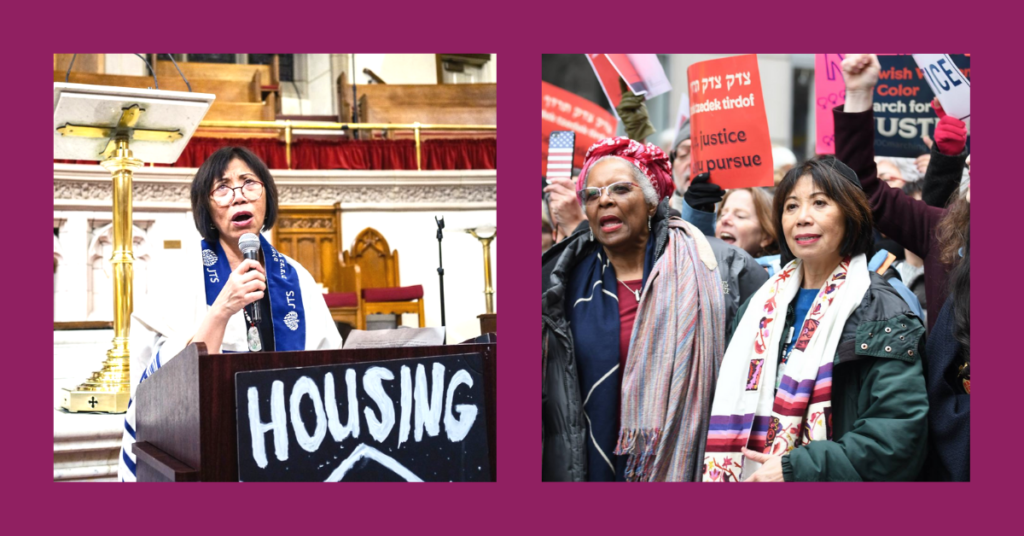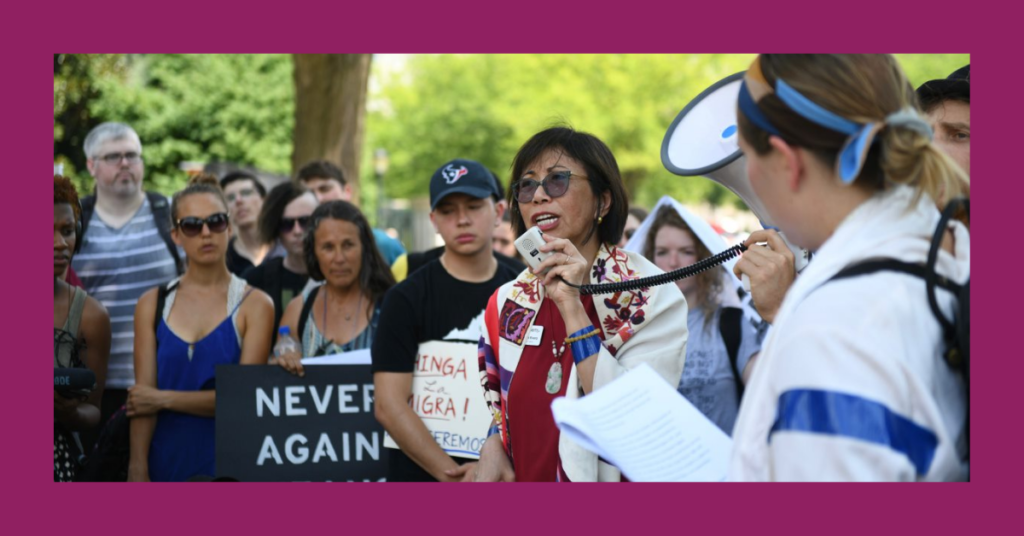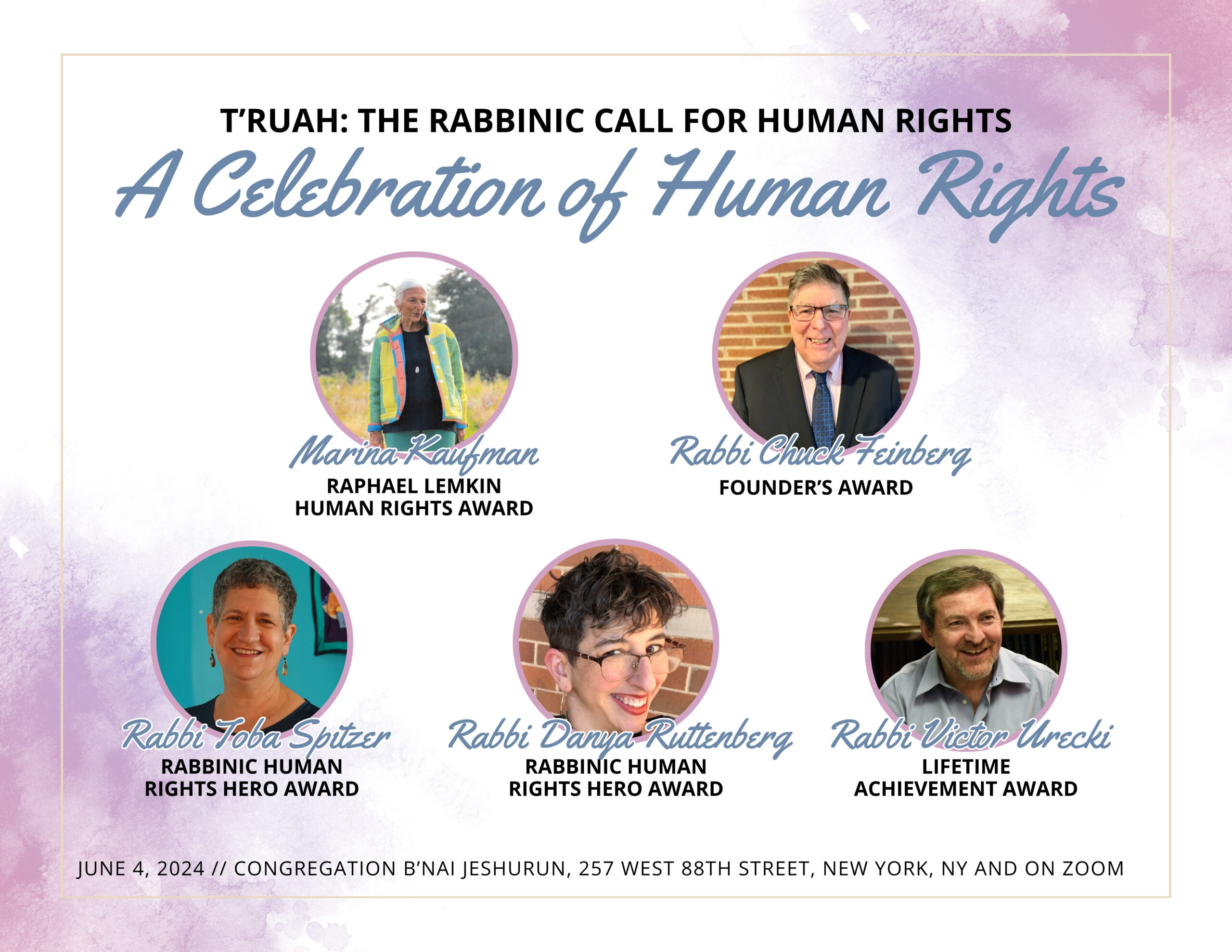Rabbi Mira Rivera is Associate Rabbi and Director of Pastoral Care at Romemu in New York City. She serves as a rabbi and mentor at Ammud: the Jews of Color Torah Academy and actively supports LUNAR: the Asian-Jewish Film Project. She has co-chaired the rabbinical council of Jews for Racial and Economic Justice (JFREJ) and continues to be part of their JOC Caucus. T’ruah spoke with Rabbi Rivera over Zoom in the fall of 2021.
(photos in header graphic by Gili Getz)
T’ruah: Tell me a little bit about yourself, and where you work. What are your days like?
Rabbi Mira Rivera: I’ve been really blessed to be with the community of Romemu since 2018. Before that, I joined them as a person just seeking spiritual community. Straight out of rabbinical school, I was a chaplain doing residency at Mount Sinai Hospital. As a chaplain, you are torn raw, by life and death and death and life, and the davening community at Romemu healed my wounded soul.
Around 2018, they invited me to be part of their Jewish Emergent Network Rabbinic Fellowship, and I accepted happily. Now I’m an Associate Rabbi there. I look into pastoral care work because I’m their chaplain. We have a community kitchen, and are beginning social action conversations. And [there is] just general life, like davening, and services, and a morning minyan that I started during the pandemic. I love the davening – the embodied aspect of Romemu that embraces that kind of spiritual practice together as a community. So it’s work and it’s not work, you know.
My other self – my ethereal self – is a rabbinic mentor at Ammud: the Jews of Color Torah Academy. We’ve been blessed with [rabbinic fellow] Kendell Pinkney, who is a rabbinical student in his last year at JTS [the Jewish Theological Seminary]. I teach Torah for them once a week, and we have a rabbinic team that fields calls from Jews of Color from all over the country – for learning individually, but also for one-on-ones – which is very rare – with a rabbi or a rabbinic mentor.
She held my hand, and she just said, “Oh my dear, you will be touching so many; you will reach more people than just through dance.”
T: Big question: What drew you to become a rabbi?
MR: When I started attending services at B’nai Jeshurun, I was really drawn to the message of Rabbi Marshall Meyer, of blessed memory. When he spoke about the experience he had growing a community in Argentina, during the rule of the juntas and all the golpes [hits], I heard him. I heard the Judaism that he spoke about loud and clear, because he spoke m’biphnim — from his inner being. I was always watching him to know what it meant to be a spiritual leader, and what it meant to humbly take on that mission in life to serve a community.
Over the years, I was teaching. I was an artist and a dancer. I danced for Martha Graham.
T: I did not know that!
MR: Martha was recognized as the doyenne of American modern dance. She brought people to the ground, stripped the corset from dancers and freed them – no shoes and really grounded work.
So I was doing that and just living in New York City in the theater and dance world, but also gradually moving into the Jewish world. I got married to an artist, a pianist, whom I met in the Graham world. We raised our children on the Upper West Side, and our community was B’nai Jeshurun. That’s how I found myself following in the call of Rabbi Marshall Meyer. Eventually, I went to rabbinical school.
One of my mentors in the dance world was Pearl Lang. She danced for Martha Graham in the 40s. She was Jewish she had an oeuvre of work that was about her heritage.
When I started in rabbinical school, I told her, “Pearl, I’m in rabbinical school.”
We were crossing the street on Broadway and 96th. She held my hand, and she just said, “Oh my dear, you will be touching so many; you will reach more people than just through dance.”
And I told her, “Pearl, you know, there is somebody who dances for Twyla Tharp who is becoming a cantor. And there’s a ballet dancer and she’s becoming a rabbi.” And her eyes just lit up, and she said, “You will all reach more people.” I remember that moment as such a blessing for me. She died soon after that.

T: Wow. Why do you think it was that there were three dancers going to rabbinical school? What do you think connects dance and being a rabbi?
MR: Martha always said the body never lies. There is no artifice; there is no pretending. You can only be who you are. And you know, the Jewish neshamah (soul) is that.
T: At what point did you realize that a rabbi could also be an activist and organizer? Is that something you knew and wanted to take advantage of before you entered rabbinical school, or something that came later?
MR: I think that being called to action is not something that happens as a professional realization at some point. You’re born with it. I was born in the United States, but I grew up in the Philippines, and I saw power, I saw privilege, I saw interdependence. I saw these very early on. I was surrounded by disparity between those who had, and could share, and those who didn’t have and had to depend. From third grade, I knew that I had to do something. I had to be part of some action.
I think being called to action is not something that happens as a professional realization. You’re born with it.
T: Did you know that being a rabbi would be a way to connect those dots?
MR: Before I entered the rabbinate, or even the Jewish world, I was doing meditation, and amongst the chevreh (community) of people doing that spiritual practice, we were doing what would be labeled as activist work.
And in the meditation world, I had colleagues who were Jewish – a lot of them! The meditation practice that I was doing had come from India, and the teacher had also this very, I guess you would say, progressive, outward-facing thrust into the world while you’re doing the inner work.
But my Jewish colleagues – I remember when we would speak about what we were doing, there was a certain urgency about the way they approached the work. A kind of urgency that was crisp and that was now and that spoke to me.
So when I heard Rabbi Marshall Meyer speak about that and embody that, it was all a seamless continuity. It was “of course, this is what they have been saying all this time.”
T: What does your community think about your organizing work?
MR: As a community, we are growing through the pandemic. When Rabbi David Ingber, the founding rabbi, started Romemu, the community had been davening in different venues all around New York and they found a home at the West End Presbyterian Church on West 105th. When the building across the street was available, the community purchased it.
For a moment, there were hearts fluttering, because historically, that building [Grosvenor Neighborhood House] had been a local Y for the community. There was a daycare center, and there were classes for the community.
And so there was this existential question: What is it going to be now? With the purchase of the building, suddenly we were neighbors, visible stakeholders even though the two communities had been in relationship for over a decade.
By starting a community kitchen, we started to bring that little corner back to life, especially during the time when faith communities had shut down their doors in order to protect their people.
T: During the pandemic.
MR: Yes, during the pandemic. This you will like: During the time when Grosvenor [Neighborhood] House was sort of diminishing in its work, a cooking show came along and said, “Can we install a working kitchen on your premises, so we can film there?” And the trustees of the Grosvenor House said yes.
So when we purchased the building, we inherited this incredible kitchen, with two huge, industrial-sized stoves for cooking. And so now we’re able to make meals, package them and then distribute them from the corner.
That’s how [my congregants are] understanding my work, and I’m able to bring them into some of the advocacy that we do – for example, in the larger neighborhood with the homeless, who had been housed in hotels temporarily during the pandemic, and other local action like that. It’s a slow burn.
And then there’s my work with Jews of Color and Asian Jews. Romemu is beginning to know that that’s also part of my rabbinate.

T: How did you first become involved with T’ruah?
MR: I first heard about the seedling of T’ruah when Rabbi Jill Jacobs would come to JTS and speak about advocacy to the rabbinical students. And when I was ordained, the first two welcome letters I received were from JFREJ (Jews for Racial and Economic Justice) and from T’ruah. That would have been 2015.
The next year, when there was the shift of administration from the Obama administration to the one that shall not be named, T’ruah invited me to participate in an action in front of the Trump Towers during the holiday of Sukkot.
There was a possibility that we would be arrested. I said that I preferred not to be arrested as a person of color – not a good thing for me – but that I would speak if needed, of the immigrant experience. Ironically, I was actually born here.
There are several T’ruah rabbis that have really reached me deeply, like Rabbi Abby Stein and Rabbi Ellen Lippmann. In many ways, I’m really indebted to them for bringing me in and giving me a T’ruah space.
Another link with T’ruah has come via a relative of ours by way of my husband. Avner Gvaryahu, the Co-Director of Shovrim Shtika [Breaking the Silence] is our cousin.
He brought me into another part of T’ruah. He came to the United States to study for two years – he and his spouse Noa Landau – and that is when a relationship with T’ruah really started to germinate from a deep place. I appreciate T’ruah for partnering with Shovrim Shtika.
T: What are the issues closest to your heart?
MR: What keeps me awake at night? Asian Jews – we are so many, so far flung, and so underserved – and Jews of Color who have no communities because they have been so burnt. That’s when I put on my chaplain hat. A lot of the work I do is just one-on-one, just finding us.
A lot of the work I do is just one-on-one, just finding us.


